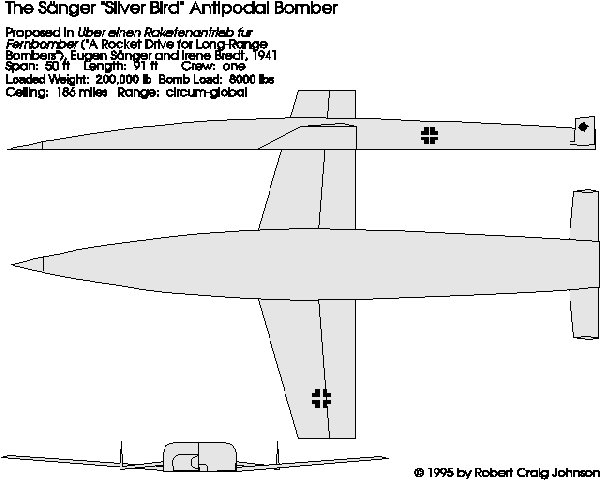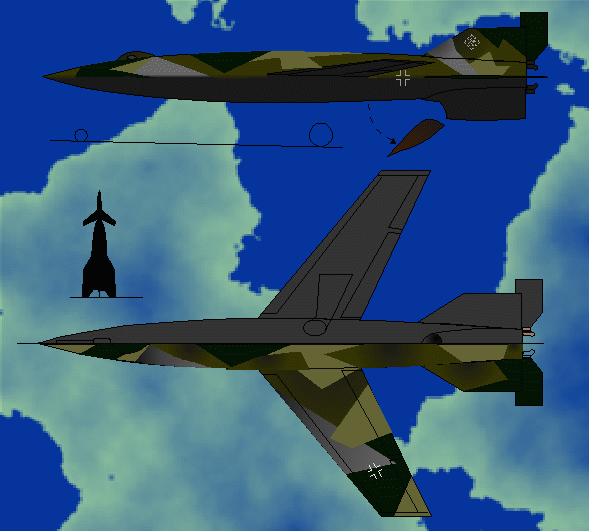
In the 1920s and '30s, Germany's Verein für Raumschaftfahrt ("Spaceship Society), a club for model rocket enthusiasts, nurtured the band of men who would eventually place men on the moon. With the encouragement of von Braun's various apologists, historians have often treated the V2 (and the slave labor system that produced it) as a militaristic aberration forced on the VfR's peace-loving idealists by a Nazi bureaucracy whose vision extended no further than new types of super-artillery. Things are seldom so simple however. While some of the prewar German and Austrian rocket enthusiasts were no doubt dazzled by romantic dreams of space voyaging and while some may have been forced to do what they did, terror weapons were never altogether foreign to their thinking. Manned space flight was, as early as the 1930s, viewed as a weapon of intercontinental war by Sänger, the acknowledged father of practical German space programs. Be that as it may, by 1945, Germany had dabbled with at least three military, manned space programs: Sänger's antipodal bomber, a manned, intercontinental, two-stage V2, and, incredibly enough given Germany's limited resources, a Nazi space station.
Popular interest in space began in Germany in the 'Twenties and peaked in the late 'Thirties. From the first, German rocketry had links with extremism. The first commercial space venture anywhere, the Magdeburg rocket of 1933, was meant to prove the Hohlweltlehr or Hollow World Doctrine of one Peter Bender. With the encouragement of anti-intellectual, no-nothing ideologues in the Nazi Party, Bender taught that Copernican cosmology was a lie. Mankind did not live on the outside of a globe orbiting a much larger sun. The universe was actually inside the earth, at the center of a hollow sphere whose inner surface was the world as we know it.If the Magdeburg rocket went straight up, it was held, it would hit the antipodes (the opposite side of the world), proving Bender's contentions. The backers of the scheme of course failed to note that no rocket flies "straight." Any sufficiently powerful rocket would be able to reach the antipodes after a curving, sub-orbital, ballistic flight, so the demonstration would prove nothing. The Bank of Magdeburg may have had its doubts about the Hohlweltlehr, but it did finance a man-carrying rocket, perhaps for publicity purposes. A series of sub-scale test shots was completed successfully, but only after a series of disasters that shook the confidence of the prospective pilots. The effort came to nothing.
Sänger's antipodal bomber was at once the earliest serious plan for manned space flight in the Germanic world and the most advanced and forward-thinking. The "Silver Bird," as the development team called it, was a hypersonic, single-stage-to-orbit aerospace plane powered, in its original form, by gasoline and liquid oxygen rocket motors. It would cruise at speeds above Mach 10 (6200 mph, or just about three times the SR-71 Blackbird's published record) at altitudes between 37 and 47 miles. It was an extraordinary conception for 1933. By 1938, when Sänger offered his creation to the Austrian war ministry, his stainless-steel wind tunnel models featured ultra-thin, knife-edged, wedge-profile wings and a flat-bottomed, plano-convex fuselage that earned the craft the further nickname of "flat iron." Sänger arrived at this shape after exhaustive trials in what were then the world's only supersonic wind tunnels, located in Germany. The design included a pressure cabin, retractable landing gear, a bomb bay, and jettisonable heat shields for the cabin windows.

In its operation, the Antipodal Bomber was a hybrid of aircraft and orbital spacecraft. It was to take off from a special rocket sled running on a monorail. When it reached 1640 ft/sec, it would lift off and climb to operational altitude in a steep, near-ballistic trajectory. But the Silver Bird would shut down its engines before attaining orbital velocity. It would sink back to earth until it bounced off the upper edge of the atmosphere. The bomber would proceed to the target like a stone skipping over the surface of a pond. After dropping its weapons, it would continue on around the globe to its base.
As near as we know, the Sänger aerospace plane got no closer to the hardware stage than the afore- mentioned wind-tunnel models. Germany's other notable manned space venture, on the other hand, was a member of the V2 rocket family. Many of its elements were actually tested using sub-scale, V2 components. The A9/A10 project was a two-stage, hypersonic, semi-ballistic manned bomber with a planned 3000-mile range. Taking the aerodynamics of the experimental, winged A4b version of the V2 for their starting point, the engineers at Germany's Peenemünde rocket center added a pressurized cockpit, landing gear, flaps, ailerons, elevators, and a turbojet sustainer engine. They planned to mount this A9 on a huge A10 booster, in essence a V2 grown to monstrous proportions.
The A9/A10 composite would take off vertically. After staging, the A9 component would follow a ballistic trajectory to the edge of space, 210 miles up. It would then fall back to earth until, 750 miles from its base, at an altitude of about 30 miles, and at speeds of over 8000 mph, the wingborne portion of the flight began. The A9 would approach its target in a high-Mach, unpowered glide. Forty-five minutes into the mission, it would release its modest one-ton bomb load, start the turbojet, and turn for home.
The most ambitious and, perhaps, delusional of the Nazi space schemes was a 1945 project for an orbital space station armed with a death ray, a huge space mirror. In 1929, Herman Oberth had proposed a potentially practical space station that served as the basis for the later project. But the 1945 station was to be one giant mirror fabricated entirely from metallic sodium. Over-sized V2 rockets were to carry the thing to its 1500-mile orbit in prefabricated sections. Here, Nazi spacemen would assemble it , using electricity provided by a system of solar-fired boilers and steam-driven dynamos. Breathable oxygen would come from pumpkins grown under flourescent light. When they were finished, the crew would steer the station over target nations, focus the sun's rays, and burn cities and boil reservoirs.
The space station is patently ridiculous, even today. It is hard to say how practical either of the rocket plane schemes could have been either, given the state of the art in the 1940s and the ever-worsening shortages of rare metals and petrochemicals. The German engineers appear to have grossly underestimated the thermal loads on a winged re-entry vehicle. These would not be on the order of an Apollo capsule, but they would still pose a formidable problem. Stainless steel might not be up to the job and was hard to fabricate. Titanium was still in the future. Inconel and the nimonic alloys that made the X-15 possible were still a few years away. Even now, the only working aerospace plane, the Space Shuttle, has to have ceramic tiles over all highly heated surfaces. Propulsion would also be a problem. As the new masters of German science, the US and USSR, discovered in the 1950s, V2-type engines could not simply be scaled up in the manner planned for the A10. Sänger-style, single-stage-to-orbit systems are still no more than a dream after sixty years.
Even if the A9/A10 or the Antipodal Bomber had been built and made to work, one wonders what it would all be for. A paltry ton of high explosive could hardly have a measurable effect on the war. It could never justify either program's staggering cost in money, raw materials, and industrial capacity. Some writers have suggested that one or both was an intended delivery vehicle for a Nazi nuclear weapon. But the Nazis had no hope of fielding an A-bomb by 1944 or 1945. In any case, it would be decades before nuclear weapons could be had in 2000-4000 lb packages (the Hiroshima and Nagasaki weapons weighed in at around 10,000 lbs each). The Nazi space program is thus best understood as little more than a self-indulgent delusion, one of many that occupied Germany's bunker-bound leadership and self-serving intelligentsia as disaster and defeat overtook the nation they professed to lead.
© 1996 by Robert Craig Johnson. First published in Eagle Droppings, the Newsletter of the Rocky Mountain Chapter, IPMS/USA.